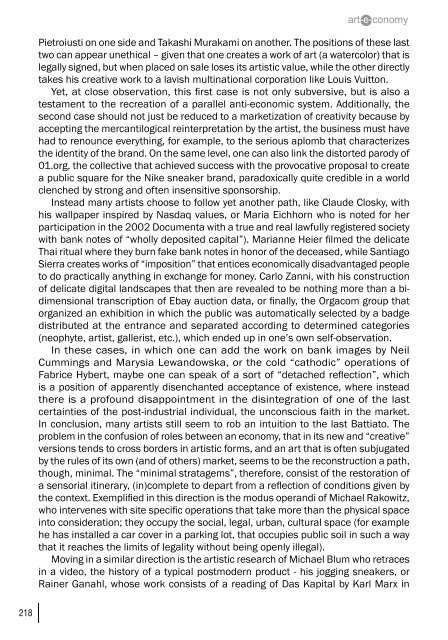art-e-conomy _ reader - marko stamenkovic
art-e-conomy _ reader - marko stamenkovic
art-e-conomy _ reader - marko stamenkovic
You also want an ePaper? Increase the reach of your titles
YUMPU automatically turns print PDFs into web optimized ePapers that Google loves.
218<br />
Pietroiusti on one side and Takashi Murakami on another. The positions of these last<br />
two can appear unethical – given that one creates a work of <strong>art</strong> (a watercolor) that is<br />
legally signed, but when placed on sale loses its <strong>art</strong>istic value, while the other directly<br />
takes his creative work to a lavish multinational corporation like Louis Vuitton.<br />
Yet, at close observation, this first case is not only subversive, but is also a<br />
testament to the recreation of a parallel anti-economic system. Additionally, the<br />
second case should not just be reduced to a marketization of creativity because by<br />
accepting the mercantilogical reinterpretation by the <strong>art</strong>ist, the business must have<br />
had to renounce everything, for example, to the serious aplomb that characterizes<br />
the identity of the brand. On the same level, one can also link the distorted parody of<br />
01.org, the collective that achieved success with the provocative proposal to create<br />
a public square for the Nike sneaker brand, paradoxically quite credible in a world<br />
clenched by strong and often insensitive sponsorship.<br />
Instead many <strong>art</strong>ists choose to follow yet another path, like Claude Closky, with<br />
his wallpaper inspired by Nasdaq values, or Maria Eichhorn who is noted for her<br />
p<strong>art</strong>icipation in the 2002 Documenta with a true and real lawfully registered society<br />
with bank notes of “wholly deposited capital”). Marianne Heier filmed the delicate<br />
Thai ritual where they burn fake bank notes in honor of the deceased, while Santiago<br />
Sierra creates works of “imposition” that entices economically disadvantaged people<br />
to do practically anything in exchange for money. Carlo Zanni, with his construction<br />
of delicate digital landscapes that then are revealed to be nothing more than a bidimensional<br />
transcription of Ebay auction data, or finally, the Orgacom group that<br />
organized an exhibition in which the public was automatically selected by a badge<br />
distributed at the entrance and separated according to determined categories<br />
(neophyte, <strong>art</strong>ist, gallerist, etc.), which ended up in one’s own self-observation.<br />
In these cases, in which one can add the work on bank images by Neil<br />
Cummings and Marysia Lewandowska, or the cold “cathodic” operations of<br />
Fabrice Hybert, maybe one can speak of a sort of “detached reflection”, which<br />
is a position of apparently disenchanted acceptance of existence, where instead<br />
there is a profound disappointment in the disintegration of one of the last<br />
certainties of the post-industrial individual, the unconscious faith in the market.<br />
In conclusion, many <strong>art</strong>ists still seem to rob an intuition to the last Battiato. The<br />
problem in the confusion of roles between an e<strong>conomy</strong>, that in its new and “creative”<br />
versions tends to cross borders in <strong>art</strong>istic forms, and an <strong>art</strong> that is often subjugated<br />
by the rules of its own (and of others) market, seems to be the reconstruction a path,<br />
though, minimal. The “minimal stratagems”, therefore, consist of the restoration of<br />
a sensorial itinerary, (in)complete to dep<strong>art</strong> from a reflection of conditions given by<br />
the context. Exemplified in this direction is the modus operandi of Michael Rakowitz,<br />
who intervenes with site specific operations that take more than the physical space<br />
into consideration; they occupy the social, legal, urban, cultural space (for example<br />
he has installed a car cover in a parking lot, that occupies public soil in such a way<br />
that it reaches the limits of legality without being openly illegal).<br />
Moving in a similar direction is the <strong>art</strong>istic research of Michael Blum who retraces<br />
in a video, the history of a typical postmodern product - his jogging sneakers, or<br />
Rainer Ganahl, whose work consists of a reading of Das Kapital by Karl Marx in


